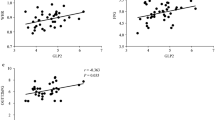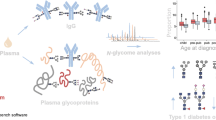Abstract
The possible occurrence of increased non-enzymatic glycosylation of serum insulin-like growth factor binding protein-3 (IGFBP-3) in vivo and the changes that would simultaneously occur in serum levels of IGFBP-3 and insulin-like growth factor-1 (IGF-I) were investigated. We measured levels of IGF-I and IGFBP-3 and the degree of glycation of total serum protein and IGFBP-3, in serum samples obtained from patients with poorly controlled non-insulin-dependent diabetes (type 2) and from age-matched non-diabetic controls. Type 2 diabetic patients had significantly higher glycated serum protein (GlyP) levels. GlyP significantly correlated with age in the control (r = 0.315, P<0.05) but not in the type 2 diabetes group. Control and diabetic subjects had comparable serum IGF-I levels and in both groups IGF-I levels tended to decrease with age (r = –0.567, P<0.001 and r = –0.465, P<0.05 for control and type 2 diabetic subjects, respectively). In the type 2 diabetes group, IGF-I levels showed a negative correlation with serum GlyP values (r = –0.476, P<0.05). Type 2 diabetic and control patients had comparable serum IGFBP-3 levels, which were significantly higher in diabetic patients in the older age subgroups. A negative correlation was found between IGFBP-3 levels and age in the control (r = –0.705, P<0.001) and in the type 2 diabetes groups (r = –0.463, P<0.05). A significant negative correlation was found between IGFBP-3 levels and GlyP in control (r = –0.449, P<0.002) but not in type 2 diabetic subjects. The mean glycated IGFBP-3 (GlyIGFBP-3) levels were higher in the oldest type 2 diabetic patients. In these patients, GlyIGFBP-3 was negatively associated with IGF-I levels (r = –0.447, P<0.05). The IGF-I/IGFBP-3 molar ratio was significantly reduced in the 46–60-year-old type 2 diabetic group, whereas the IGF-I/IGFBP-3 ratio was positively and significantly correlated with GlyP levels only in the control group (r = 0.489, P<0.01). Our results show that: a) increased non-enzymatic glycosylation of IGFBP-3 occurs in vivo; and b) this effect is accompanied by an increase in IGFBP-3 levels. These results suggest that the IGF-I/IGFBP-3 system is another target for the metabolic derangements of type 2 diabetes. Its alterations might play a role in diabetic complications.
Similar content being viewed by others
Author information
Authors and Affiliations
Additional information
Received: 22 September 1997 / Accepted in revised form: 30 April 1998
Rights and permissions
About this article
Cite this article
Cortizo, A., Lee, P., Cédola, N. et al. Relationship between non-enzymatic glycosylation and changes in serum insulin-like growth factor-1 (IGF-1) and IGF-binding protein-3 levels in patients with type 2 diabetes mellitus. Acta Diabetologica 35, 85–90 (1998). https://doi.org/10.1007/s005920050109
Issue Date:
DOI: https://doi.org/10.1007/s005920050109




